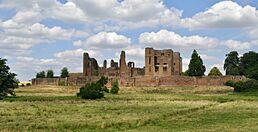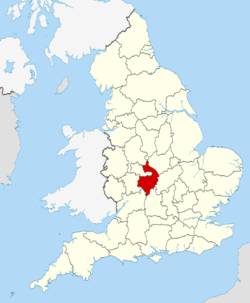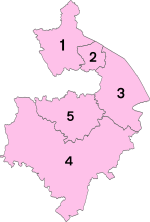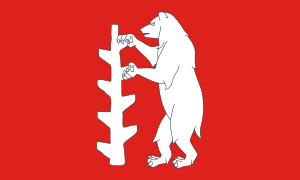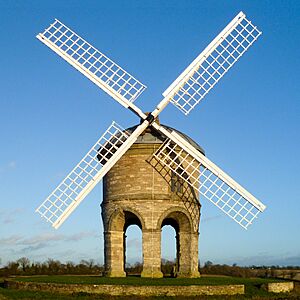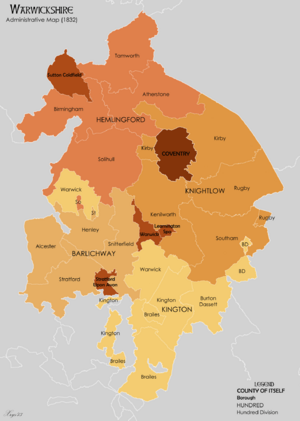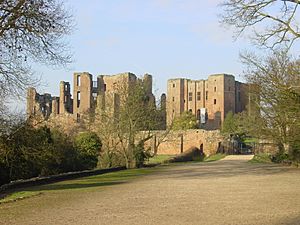Warwickshire facts for kids
Quick facts for kids
Warwickshire
|
|||||||||||||||||||||||||||||||||||||||||||||||||||||
|---|---|---|---|---|---|---|---|---|---|---|---|---|---|---|---|---|---|---|---|---|---|---|---|---|---|---|---|---|---|---|---|---|---|---|---|---|---|---|---|---|---|---|---|---|---|---|---|---|---|---|---|---|---|
|
Kenilworth Castle; statue of George Eliot, Nuneaton; and Royal Shakespeare Theatre, Stratford-upon-Avon
|
|||||||||||||||||||||||||||||||||||||||||||||||||||||
| Sovereign state | United Kingdom | ||||||||||||||||||||||||||||||||||||||||||||||||||||
| Constituent country | England | ||||||||||||||||||||||||||||||||||||||||||||||||||||
| Region | West Midlands | ||||||||||||||||||||||||||||||||||||||||||||||||||||
| Established | Historic | ||||||||||||||||||||||||||||||||||||||||||||||||||||
| Time zone | UTC±00:00 (Greenwich Mean Time) | ||||||||||||||||||||||||||||||||||||||||||||||||||||
| • Summer (DST) | UTC+01:00 (British Summer Time) | ||||||||||||||||||||||||||||||||||||||||||||||||||||
| Members of Parliament | 6 MPs | ||||||||||||||||||||||||||||||||||||||||||||||||||||
| Largest town | Nuneaton (ceremonial) Birmingham (historic) | ||||||||||||||||||||||||||||||||||||||||||||||||||||
|
|||||||||||||||||||||||||||||||||||||||||||||||||||||
Warwickshire (![]() i/ˈwɒrɪkʃər, -ʃɪər/; often called Warks) is a county in the West Midlands of England. It is bordered by several other counties. These include Staffordshire and Leicestershire to the north. To the east, you'll find Northamptonshire. Oxfordshire and Gloucestershire are to the south. Finally, Worcestershire and the West Midlands county are to the west.
i/ˈwɒrɪkʃər, -ʃɪər/; often called Warks) is a county in the West Midlands of England. It is bordered by several other counties. These include Staffordshire and Leicestershire to the north. To the east, you'll find Northamptonshire. Oxfordshire and Gloucestershire are to the south. Finally, Worcestershire and the West Midlands county are to the west.
The biggest town in Warwickshire is Nuneaton. The main administrative town, known as the county town, is Warwick. Most of Warwickshire is countryside. It covers an area of about 1,975 square kilometres (763 square miles). Around 571,010 people live here. Besides Nuneaton, other large towns are Rugby, Leamington Spa, Warwick, Bedworth, and Stratford-upon-Avon.
Warwickshire is mostly flat land. However, in the very south, you can find a small part of the Cotswolds. This area is known for its natural beauty. The River Avon flows through the southern part of the county. This river is a major branch of the Severn.
This region was once part of Roman Britain. Later, a Roman road called Watling Street became a border. It separated the Anglo-Saxon kingdom of Mercia from the Danelaw. Warwickshire remained fairly peaceful through the Middle Ages. Coventry grew into an important centre for making textiles. The famous writer William Shakespeare was born in Stratford-upon-Avon in 1564. He lived most of his life there. The Gunpowder Plot of 1605 was planned near Snitterfield.
During the Industrial Revolution, coal was mined in Warwickshire. Coventry and the western part of the county became places where many things were made. Leamington Spa became a popular place for tourists. The famous writer Mary Ann Evans, known as George Eliot, was born near Nuneaton in 1819.
Contents
- Exploring Warwickshire's Geography
- Fun Places to Visit in Warwickshire
- Warwickshire's Economy and Jobs
- Towns and Villages in Warwickshire
- A Look Back: History of Warwickshire
- Learning in Warwickshire: Education
- Getting Around: Transport in Warwickshire
- Media in Warwickshire
- Sports in Warwickshire
- Special Honours for the County
- Famous People from Warwickshire
- See also
Exploring Warwickshire's Geography
Warwickshire shares borders with many other counties. These include Leicestershire to the northeast and Staffordshire to the northwest. To the west are Worcestershire and the West Midlands. Northamptonshire is to the east and southeast. Finally, Gloucestershire is to the southwest and Oxfordshire to the south. The very northern tip of the county is only 3 kilometres (3 miles) from the Derbyshire border. Warwickshire is an average-sized English county. It stretches about 56 kilometres (35 miles) from north to south.
Most people in Warwickshire live in the north and centre. Towns in northern and eastern Warwickshire became industrial in the 1800s. These towns include Atherstone, Bedworth, Coleshill, Nuneaton, and Rugby. Major industries used to be coal mining, textiles, engineering, and cement making. Now, heavy industry is less common. It has been replaced by places for storing and moving goods, lighter industries, and services. Nuneaton and Rugby (famous for being the birthplace of rugby football) are the most well-known of these towns.
The towns in central and western Warwickshire are more prosperous. These include Leamington Spa, Warwick, Stratford-upon-Avon, Kenilworth, Alcester, Southam, and Wellesbourne. Here, tourism, gaming, and services are the main jobs.
The north of the county has gently rolling hills. The highest point here is 178 metres (581 feet) near Hartshill. The northernmost village, No Man's Heath, is only 34 kilometres (21 miles) south of the Peak District National Park.
The south of the county is mostly rural. Not many people live there. It includes a very small part of the Cotswolds. This area is on the border with northeast Gloucestershire. The flat land between the Cotswolds and the Edgehill hills is called the Vale of Red Horse. The only town in the south of Warwickshire is Shipston-on-Stour. The highest point in the entire county is Ebrington Hill. It is 261 metres (856 feet) high and is also on the border with Gloucestershire.
Warwickshire does not have any cities today. This is because Coventry and Birmingham became part of the West Midlands county in 1974. They are now their own special areas. In 2011, the largest towns in Warwickshire (with over 20,000 people) were: Nuneaton (81,900), Rugby (70,600), Leamington Spa (49,500), Bedworth (32,500), Warwick (30,100), Stratford (25,500), and Kenilworth (22,400).
Arden and Felden: Historic Landscapes
A large part of western Warwickshire was once covered by an old forest. This was the ancient Forest of Arden. Most of it was cut down to provide fuel for industries. This is why many places in central-western Warwickshire have "-in-Arden" in their names. Examples include Henley-in-Arden, Hampton-in-Arden, and Tanworth-in-Arden. The rest of the area, which was not part of the forest, was called the Felden. This name comes from an old word for "field." Today, it is a rolling countryside used for farming. The rivers Avon and Leam flow through this area.
How Warwickshire's Borders Changed
Areas that were historically part of Warwickshire include Coventry, Solihull, Sutton Coldfield, and parts of Birmingham. This includes the city centre, Aston, Castle Bromwich, Digbeth, Edgbaston, Erdington, Hodge Hill, Ladywood, Nechells, Saltley, Shard End, Sheldon, Small Heath, and Sparkbrook. These areas became part of the new metropolitan county of West Midlands in 1974. Sutton Coldfield became part of Birmingham at that time.
In 1986, the West Midlands County Council was removed. Birmingham, Coventry, and Solihull became like independent areas. However, the West Midlands county name is still used for special events. Since 2016, it has been part of the West Midlands Combined Authority. This group helps with transport, economy, and rebuilding areas. Some groups, like Warwickshire County Cricket Club, still use the old county borders. This cricket club is based in Edgbaston, which is in Birmingham.
The flag of the historic county was officially registered in 2016. It shows a bear and ragged staff on a red background. This symbol has been linked to the county for a very long time.
Coventry is almost in the middle of the Warwickshire area. It still has strong connections with the county. Sometimes, Coventry and Warwickshire are seen as one area. They share a Chamber of Commerce, a business partnership, and a BBC Local Radio Station.
Coventry was managed separately from the rest of Warwickshire for many years. This was between 1451 and 1842. It was called the County of the City of Coventry. In 1842, it became part of Warwickshire again. The town of Tamworth used to be split between Warwickshire and Staffordshire. But since 1888, it has been fully in Staffordshire.
Green Spaces: The Green Belt
Warwickshire has a large area of green belt. This is land kept open to stop cities from growing too much. It surrounds the West Midlands and Coventry areas. This green belt was first planned in the 1950s. All of Warwickshire's districts have some part of this green belt.
Fun Places to Visit in Warwickshire
- Anne Hathaway's Cottage
- Arbury Hall
- Battle of Edgehill
- The Belfry
- Brinklow Castle
- British Motor Museum
- Burton Dassett Hills
- Caldecotte Park
- Charlecote Park
- Charlecote Water Mill
- Chesterton Windmill
- Compton Verney House
- Compton Wynyates
- Coombe Abbey
- Coombe Country Park
- Coughton Court
- Coventry Canal
- Draycote Water
- Grand Union Canal
- Guy Fawkes House
- Hartshill Hayes Country Park
- Hatton Country World
- Jephson Gardens
- Kenilworth Castle
- King Edward VI School
- Kingsbury Water Park
- Ladywalk Reserve
- Lunt Roman Fort
- Lord Leycester Hospital
- Lowsonford
- Mary Arden's House
- Midland Air Museum
- Newbold Quarry Park
- Nuneaton Museum & Art Gallery
- Oxford Canal
- Ragley Hall
- River Avon
- Rollright Stones
- Royal Pump Rooms
- Royal Shakespeare Theatre
- Rugby Art Gallery and Museum
- Rugby School
- Ryton Pools Country Park
- Shakespeare's Birthplace
- Shakespeare's New Place
- St. Nicholas' Park
- Swift Valley Nature Reserve
- The Forest Hermitage
- University of Warwick
- Warwick Castle
- Warwick School
- Webb Ellis Rugby Football Museum
- Wellesbourne Wartime Museum
Warwickshire's Economy and Jobs
Warwickshire has a strong and growing economy. The car industry is a big part of it. In the north, BMW's Hams Hall factory employs over 1,000 people. Jaguar Land Rover and Aston Martin Lagonda have their main offices in Gaydon in the south. They also have a huge centre for making new cars there.
Warwickshire is also becoming known as a global centre for the video game industry. One of Britain's oldest game studios, Codemasters, has been in Southam for many years. The area around Southam, Royal Leamington Spa, and Warwick is now called "Silicon Spa." It is home to many game studios. These studios employ over 2,000 skilled people. This is more than 10% of all game developers in the UK!
The region is also becoming a leader in battery technology. In 2021, big plans were announced. These include a £130 million UK Battery Industrialisation Centre (UKBIC) in Coventry.
Tourism is another important area for jobs. There are many country parks, rural areas, and historic towns across the county. Tourism brings in over £1 billion to the local economy. It also supports almost 20,000 jobs.
Towns and Villages in Warwickshire
Main Warwickshire towns:
Smaller towns and large villages include:
- Alcester
- Atherstone
- Bidford-on-Avon
- Bulkington
- Coleshill
- Henley-in-Arden
- Kingsbury
- Polesworth
- Shipston-on-Stour
- Southam
- Studley
- Water Orton
- Wellesbourne
- Whitnash
A Look Back: History of Warwickshire
Warwickshire became a county in the early 1000s. It was part of the kingdom of Mercia. The first time Warwickshire was mentioned was in 1001. It was called Wæringscīr, and was named after Warwick. The name wara- means "those who care for or protect." The part -wick is an old English word for village. Near Warwick, you can find villages like Long Itchington and Bishop's Itchington. They are along the River Itchen.
During the Middle Ages, Coventry was the most important city in Warwickshire. It was one of the biggest cities in England. This was because it was a major centre for making textiles. Warwickshire played a key role in the English Civil War. The Battle of Edgehill and other small fights happened in the county. During the Industrial Revolution, Warwickshire became a leading industrial county. Big industrial cities like Birmingham and Coventry were within its borders.
Changes to Warwickshire's Borders Over Time

Warwickshire's borders have changed many times.
- In 1844, some areas were moved into or out of the county.
- In 1888, parts of Tamworth that were in Warwickshire became part of Staffordshire.
- In the early 1900s, several areas like Harborne, Balsall Heath, Quinton, Handsworth, Yardley, and Perry Barr were added to Birmingham. Since Birmingham was then in Warwickshire, these areas also became part of Warwickshire.
- In 1931, the borders with Gloucestershire and Worcestershire were adjusted. This helped to remove small parts of counties that were surrounded by another county. For example, Shipston-on-Stour joined Warwickshire from Worcestershire.
- In 1974, a big change happened. Birmingham, Coventry, Solihull, and Sutton Coldfield became part of the new West Midlands county. Sutton Coldfield then became part of Birmingham.
Learning in Warwickshire: Education
In Warwickshire, children start primary school when they are five years old. They usually stay there for seven years, until they are eleven. Warwickshire is one of the few areas in England that still has grammar schools. These are special schools that children can get into by passing an exam. They are in the Stratford-on-Avon and Rugby areas.
In their last year of primary school, children can take the 11-plus exam. This test helps them try for a place at one of the five grammar schools. These include Stratford-upon-Avon Grammar School for Girls, King Edward VI School, Stratford-upon-Avon (for boys), Lawrence Sheriff Grammar School for Boys, Rugby High School for Girls, and Alcester Grammar School (for both boys and girls). The 11-plus test has two parts. Each part has questions about words, numbers, and patterns.
Warwickshire also has four colleges for further education. These are North Warwickshire & Hinckley College, King Edward VI Sixth Form College in Nuneaton, Stratford-upon-Avon College, and the Warwickshire College Group. This group is made up of six colleges that have joined together.
There are also six private senior schools in the county. These include Rugby School, Warwick School, Princethorpe College, Kingsley School, Arnold Lodge School, and the King's High School For Girls.
Some of Warwickshire's grammar and private schools are very old and important. King Edward VI School, Stratford-upon-Avon still uses school buildings from the 1200s. It is likely where William Shakespeare went to school. Rugby School was started in 1567. Warwick School was founded around 914 AD. This makes it the oldest boys' school still running in the country. Rugby School is one of the "great" English public schools.
There are no universities completely inside Warwickshire. However, the University of Warwick is on the border with Coventry. Some parts of the university, like Lakeside Village and Warwick Business School, are within Warwickshire's borders. The university also has a small campus near Wellesbourne. This campus is home to the Warwick Horticultural Research Centre.
Getting Around: Transport in Warwickshire
Roads for Travel
Several major motorways run through Warwickshire. These are fast roads that connect different parts of the country.
- The M40 motorway connects London to Birmingham. It goes through the middle of Warwickshire. It serves towns like Leamington Spa, Warwick, and Stratford.
- The M6 motorway connects North West England and the West Midlands to the M1 motorway. The M1 then goes to London. The M6 runs through the north of Warwickshire. It serves Rugby, Nuneaton, and Bedworth on its way to Birmingham.
- The M69 connects Coventry to Leicester. It serves Nuneaton.
- Other motorways also pass briefly through Warwickshire. These include the M45 (a short road south of Rugby that connects to the M1). The southern end of the M6 Toll and the M42 also pass through the county at different points.
Other important main roads in Warwickshire include:
- The A45 goes through Birmingham, Coventry, and Rugby. Then it goes east into Northamptonshire.
- The A46 connects the M40 to the M6. It passes through Warwick, Kenilworth, and Coventry.
- The A452 connects Leamington to Birmingham.
- The A5 goes through Atherstone. Then it goes east of Nuneaton and east of Rugby. It marks the border with Leicestershire.
- The A444 goes through Nuneaton and Bedworth.
Trains in Warwickshire
Main Train Lines
Two main railway lines cross Warwickshire:
- The Chiltern Main Line follows an old route from London Paddington to Birmingham Snow Hill. It goes through the centre of Warwickshire. It has stations at Leamington Spa, Warwick, Warwick Parkway, Hatton, and Lapworth. You can also find two smaller lines branching off the Chiltern line: the Leamington to Coventry and Leamington-Stratford lines.
- The West Coast Main Line (WCML) also runs through Warwickshire. At Rugby, this line splits into two. One part goes west to Coventry and Birmingham. The other part, the Trent Valley Line, goes north-west towards Stafford, North West England, and Scotland. This section has stations at Nuneaton, Atherstone, and Polesworth (for trains going north only). There is also a branch line from Nuneaton to Coventry. It has stations at Bermuda Park, Bedworth, and Coventry Arena.
Other Train Lines
Other railway lines in Warwickshire include:
- The Birmingham-Nuneaton part of the Birmingham to Peterborough Line. This line continues east of Nuneaton towards Leicester and Peterborough. Nuneaton has direct trains to Birmingham and Leicester on this line. There are two stations in the far north-west of the county: Water Orton and Coleshill.
- The North Warwickshire Line goes from Birmingham to Stratford-upon-Avon. This line used to go south to Cheltenham, but now it ends at Stratford. There is a station on this line at Henley-in-Arden and in several small villages. Stratford also has direct train services to London.
Between 1965 and 2018, Kenilworth was the only major town in Warwickshire without a train station. The line from Leamington to Coventry goes through the town. But the station was closed many years ago. Kenilworth railway station was rebuilt and opened in April 2018. Now, trains run every hour to Coventry and Leamington.
High Speed 2 (HS2)
A new high-speed train line called High Speed 2 (HS2) is being built through Warwickshire. However, there will be no stations in the county. It will pass south of Southam, then between Kenilworth and Coventry. After that, it will go into the West Midlands towards Birmingham.
Air Travel
Coventry Airport is located in the Warwickshire village of Baginton.
Canals and Waterways
Canals and rivers that boats can use in Warwickshire include:
- The Coventry Canal. This canal runs through the north of the county. It goes from Coventry through Bedworth, Nuneaton, Atherstone, and Polesworth. Then it continues to Tamworth.
- The Ashby-de-la-Zouch Canal briefly passes through Warwickshire. It connects with the Coventry Canal at Bedworth.
- The Oxford Canal starts near Coventry. Then it goes east around Rugby and through the rural south of the county towards Oxford.
- The Grand Union Canal runs through Leamington and Warwick. Then it continues to Birmingham.
- The restored Saltisford Canal Arm is near the centre of Warwick. It is a short branch of the Grand Union Canal. This arm is what's left of the original end point of the Warwick and Birmingham Canal. It dates back to 1799.
- The Stratford-upon-Avon Canal runs from the Grand Union west of Warwick to Stratford. There, it joins the Avon River.
- The River Avon flows through Warwickshire from southwest to northeast. It goes through Stratford, Warwick, and Rugby. Boats can travel on it for 47 miles (76 kilometres). This is from the River Severn at Tewkesbury to Alveston weir just east of Stratford-upon-Avon. This makes it the only river in Warwickshire that boats can use. There were ideas to extend the Avon navigation 13 miles (21 kilometres) to Warwick. However, these plans are not likely to happen.
Media in Warwickshire
Television
The county gets its TV news from BBC West Midlands and ITV Central. These stations broadcast from studios in Birmingham. Television signals come from either the Lark Stoke or Sutton Coldfield TV transmitters.
Radio
BBC Local Radio for Warwickshire is BBC CWR. It broadcasts from its studios in Coventry. However, the North Warwickshire area gets its BBC radio from BBC Radio WM. Other commercial radio stations that cover the whole county include Capital Mid-Counties, Free Radio Coventry & Warwickshire, Fresh (Coventry & Warwickshire), Heart West Midlands, and Greatest Hits Radio Midlands.
Sports in Warwickshire
Cycling Fun
Warwickshire's country roads, canal paths, and old towns are very popular with people who love cycling. The county has become a major cycling spot. It has hosted a stage of the Women's Tour since 2016. It also hosted the Men's Tour of Britain in 2018 and 2019.
In 2022, St Nicholas Park in Warwick hosted the Elite Men's and Women's Road Race. This was part of the Commonwealth Games held in Birmingham.
Football Teams
Warwickshire does not have any teams in the top professional English Football League. As of the 2022–23 season, the highest-ranked team is Leamington. They play in the National League North, which is the sixth level of English football. One level below them, in the Southern Football League Premier Division Central, are Nuneaton Borough and Stratford Town. Other local clubs include Rugby Town, Bedworth United, Southam United, Racing Club Warwick, Coleshill Town, Atherstone Town, and Nuneaton Griff. All these clubs are part of the Birmingham FA.
Some famous football clubs are located within the historic borders of Warwickshire. These include Aston Villa (an English Premier League team), and Football League clubs Birmingham City and Coventry City. Also, National League club Solihull Moors and Southern League Division One Central club Sutton Coldfield Town are in this historic area.
Parkrun Events
There are six Saturday morning 5km parkruns in Warwickshire. These are for all ages and abilities. You can find them in Leamington, Stratford upon Avon, Rugby, Bedworth, Southam, and Kingsbury. There are also three Sunday 2km junior events for younger runners. These are in Stratford upon Avon, Rugby, and Warwick.
Cricket in Warwickshire
Warwickshire County Cricket Club plays at Edgbaston Cricket Ground in Birmingham. This ground was historically part of Warwickshire. Many famous English players have played for this team. These include Eric Hollies, M.J.K. Smith, Bob Willis, Dennis Amiss, Jonathan Trott, Ian Bell, Moeen Ali, and Chris Woakes. International players have also played here, such as Alvin Kallicharran, Rohan Kanhai, Brian Lara, Allan Donald, and Shaun Pollock. In 2014, the club partly changed its name for its Twenty20 team to the Birmingham Bears. Many supporters were not happy about this.
Other cricket grounds in modern-day Warwickshire have hosted important matches. These include:
- Griff and Coton Ground, Nuneaton – 26 matches (last in 1980)
- Arlington Avenue, Leamington Spa – 4 matches (last in 1910)
- Swan's Nest Lane, Stratford-upon-Avon – 3 matches (last in 2005)
- Weddington Road, Nuneaton – 3 matches (last in 1914)
Gaelic Sports
The Warwickshire County Board of the Gaelic Athletic Association (GAA) is in charge of Gaelic games in Warwickshire. This board also manages the Warwickshire inter-county teams. They play their home games at Páirc na hÉireann.
Polo
The Dallas Burston Polo Club is a polo club with six fields. It is located near Southam.
Water Polo
Warwick Water Polo club plays in the Midland League. They train in Warwick, Banbury, and Coventry.
Special Honours for the County
In March 2014, the Royal Regiment of Fusiliers was given the "freedom of the county." This is a special honour. It was officially given after a parade through Warwick on June 6, 2014.
Famous People from Warwickshire
Warwickshire is the birthplace of William Shakespeare from Stratford-upon-Avon. Road signs at the county border often say "Shakespeare's County." The county has also produced other famous people. These include Aleister Crowley (from Royal Leamington Spa), George Eliot and Ken Loach (from Nuneaton), Rupert Brooke (from Rugby), and Michael Drayton (from Hartshill). The poet Philip Larkin lived in Warwick (he was born in nearby Coventry). Folk musician Nick Drake lived and died in Tanworth-in-Arden. Frank Whittle, who invented the jet engine, was born in Coventry. He had strong ties to Warwickshire. He grew up in Leamington Spa and did much of his work in Rugby.
See also
 In Spanish: Warwickshire para niños
In Spanish: Warwickshire para niños


